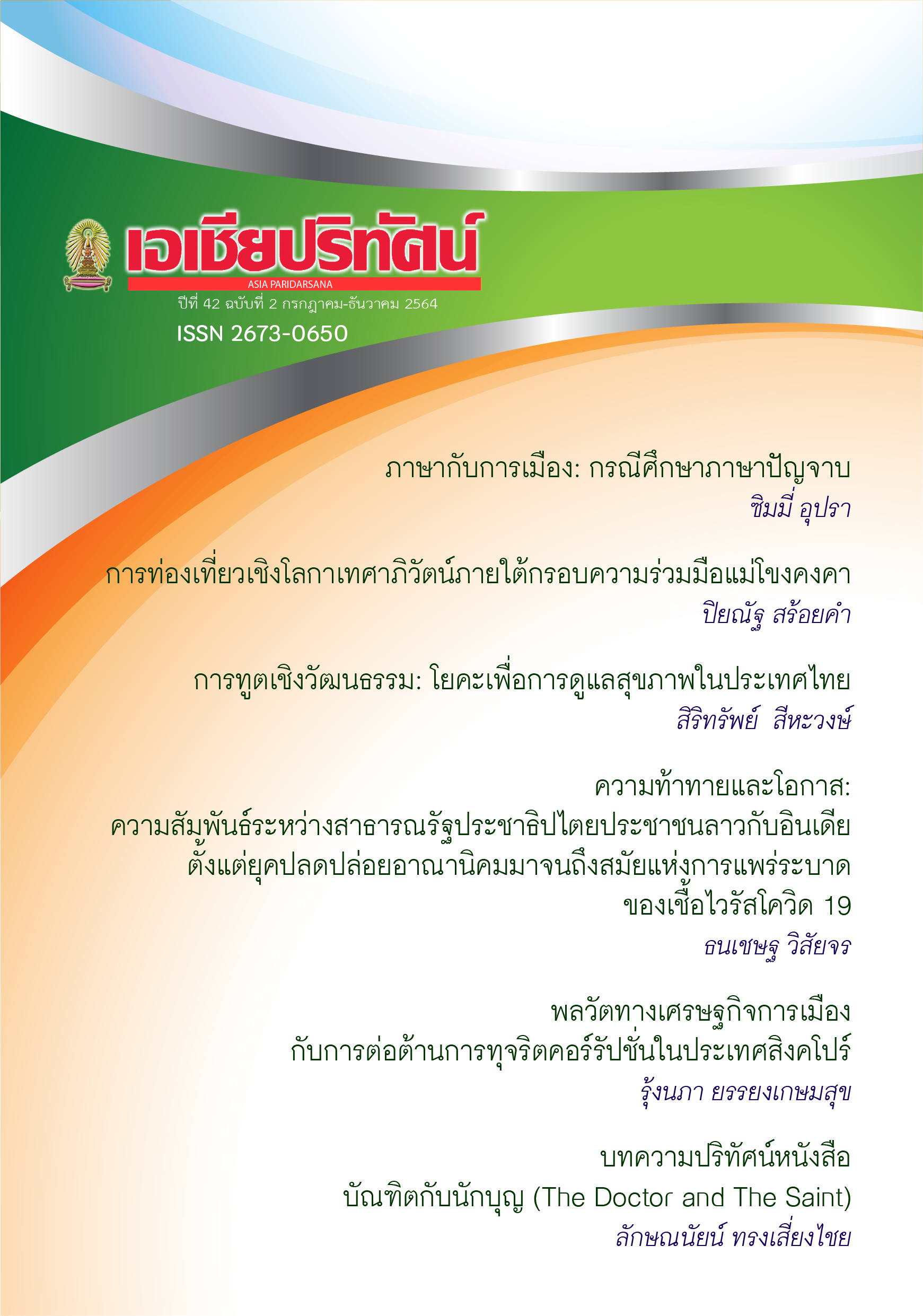ภาษากับการเมือง: กรณีศึกษาภาษาปัญจาบ
Main Article Content
บทคัดย่อ
บทความเรื่อง ภาษากับการเมือง: กรณีศึกษาภาษาปัญจาบ มีวัตถุประสงค์เพื่อนำเสนอสภาพสังคม วัฒนธรรม การเมือง ที่มีอำนาจในการกำหนดบทบาทของภาษาปัญจาบ โดยศึกษาจากการสัมภาษณ์ผู้รู้ ผู้บอกภาษา และการรวบรวมเอกสารวรรณกรรมที่เกี่ยวข้อง และนำข้อมูลมาวิเคราะห์ สังเคราะห์ นำเสนอผลเชิงพรรณนา
ผลการศึกษาพบว่า ภาษาปัญจาบมีถิ่นกำเนิดอยู่ในพื้นที่ทางสังคมวัฒนธรรมในอินเดียเดิม (The greater India) ก่อนการเข้ามาของอังกฤษและก่อนที่จะเกิดการแยกประเทศ มีอาณาบริเวณครอบคลุมจากรัฐปัญจาบในอินเดียไปจนถึงรัฐปัญจาบในภาษา
ปัญจาบ มีตัวอักษรใช้ 2 แบบคือ ตัวอักษรคุรุมุขิ (Gurumukhi) ที่ใช้ในปัญจาบอินเดียและ ตัวอักษรชาฮ์มุขิ (Shahmukhi) ที่ใช้ในปัญจาบปากีสถาน คำศัพท์ที่ใช้ในภาษาปัญจาบอินเดียมาจากภาษาสันสกฤต ภาษาเปอร์เซีย และ ภาษาอุรดู
การเมืองเป็นปัจจัยทางสังคมที่มีอำนาจในการกำหนดบทบาทของภาษาปัญจาบในสังคม
ปัญจาบทั้งในปัญจาบอินเดียและปัญจาบปากีสถาน สถานะของภาษาปัญจาบเปลี่ยนไปตามสถานการณ์ทางสังคมและการเมืองในอินเดียและปากีสถาน บทความนี้นำเสนอสถานะของภาษา
ปัญจาบโดยแบ่งเป็น 4 ช่วงเวลา คือ 1. ภาษาปัญจาบในอินเดียเดิม 2. ภาษาปัญจาบภายใต้การปกครองของอังกฤษ 3.ภาษา
ปัญจาบภายหลังการผนวกเข้ากับอังกฤษ และ 4. ภาษาปัญจาบหลังการแยกประเทศ
Article Details
เอกสารอ้างอิง
ภาษาไทย
วิไลลักษณ์ จูววราหะวงศ์ และ วิไลลักษณ์ จูวราหะวงศ์, 2543. วรรณยุกต์ภาษาไทยกรุงเทพฯ ที่พูดโดยคนไทย คนแต้จิ๋ว และคนซิกซ์. กรุงเทพฯ: จุฬาลงกรณ์มหาวิทยาลัย
อภิรัฐ คำวัง. 2554. เปรม ปราณ ปัญจาบ บันทึกการเดินทางกับภาคสนามอินเดียศึกษาในรัฐปัญจาบ.ศูนย์ภารตะศึกษา สภาบันวิจัยภาษาและวัฒนธรรมเอเชีย มหาวิทยาลัยมหิดล.
อภิรัฐ คำวัง. 2559. สิงห์ปัญจาบ ณ สยามประเทศ: ประวัติศาสตร์ ปรัชญาศาสนา สังคมวัฒนธรรม รวมบทความวิชาการว่าด้วยเรื่องราวของชาวไทยซิกข์. ศูนย์ภารตะศึกษา สภาบันวิจัยภาษาและวัฒนธรรมเอเชีย มหาวิทยาลัยมหิดล.
ภาษาอังกฤษ
Ayres, A. 2008. “Language, the Nation, and Symbolic Capital: The Case of Punjab.” The Journal of Asian Studies 67 (3): 917-946.
Bahri, H.D. 2003. Teach Yourself Punjabi. Patiala: Punjabi University.
Bhatt, S.K. 2007. Hindi: Complete Course for Beginners. USA: Random House, Living Languages.
Department of Higher Education. Ministry of Human Resource Development. the Government of India. 2018. http://mhrd.gov.in/language-education
Ethnologue. 2014. Language Databases. www.ethnologue.org.
Grierson, G.A. 2014. Linguistic Survey of India Database. http://www.joao-roiz.jp/LSI/
Lochan, A. 2006. The encyclopedia of Indian Diaspora. ed. Brij V.Lal, Perter Reeves, & Rajesh Rai. 189-194.National University of Singapore.
Lohal and Goyal (n.d.) Comparative Study of Hindi and Punjabi Language Scripts. Department of Computer Science, Punjabi University Patiala.
Ministry of Home Affairs. Department of Foreign Languages. http://rajbhasha.nic.in/en/constitutional-provisions
Sandhu, B.S. 1986. The Articulatory and Acoustic Structure of the Panjabi Consonants. Patiala: Punjabi University Patiala.
Sekhon, S.S. and Duggal, K.S. 1992. A History of Punjabi Literature. New Delhi: Sahitya Akademi.
Singh, K. 2004a. A History of the Sikhs. Vol 1. Oxford University Press.
Singh, K. 2004b. A History of the Sikhs. Vol 2. Oxford University Press.
Rehman, T. 2008. Language, ideology and power: Language learning among the Muslims of Pakistan and North India. Delhi: Glorious Printers.
University of Patiala (retrieved,2014). www.learningpunjabi.org
ภาพอ้างอิงจากสื่อออนไลน์
Punjabi_Alphabet.jpg จาก http://upload.wikimedia.org/wikipedia/commons/3/30/Punjabi_Alphabet.jpg
Shahmukhi Alphabet จาก http://th.wikipedia.org/wiki/อักษรชาห์มุขี


